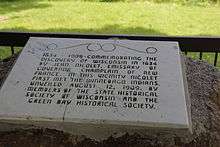Jean Nicolet

Jean Nicolet (Nicollet) de Belleborne (ca. 1598 – 1 November 1642) was a French coureur des bois noted for exploring Green Bay of Lake Michigan, in what is now the U.S. state of Wisconsin.
Early life
Nicolet (Nicollet) was born in Cherbourg-Octeville, France, in the late 1590s, the son of Thomas Nicollet, who was "messenger ordinary of the King between Paris and Cherbourg", and Marguerite de Lamer. They were members of the Roman Catholic Church. He was a known friend of Samuel De Champlain and Etienne Brule. He was attracted to Canada to participate in Samuel Champlain's plan to train young French men as explorers and traders by having them live among Native Americans. The French were setting up fur trading under the Compagnie des Marchands.[1]
Arrival at Quebec
In 1618, Nicolet immigrated to Quebec as a clerk to train as an interpreter for the Compagnie des Marchands, a trading monopoly owned by members of the French aristocracy. As an employee, Jean Nicolet was a faithful supporter of the Ancien Régime.
To learn the language of the First Nations, Nicolet was sent to live with the Algonquins on Allumette Island, a friendly settlement located along the important Ottawa River fur trade route. Upon his return to Quebec in 1620, he was assigned to live among the Odawa and Algonquin people in the Lake Nipissing region. During his nine-year stay, he ran a store and traded with the native peoples in the area.[1]
He had a relationship with Jeanne Nipissing, a Nipissing native, and they had a daughter, whom he named Madeleine Euphrosine Nicolet. When Nicolet returned to Quebec, he brought his daughter Madeleine with him to educate her among the French. On July 19, 1629, when Quebec fell to the Kirke brothers who took control for England, Jean Nicolet fled with his daughter to the safety of the Huron country. He worked from there against English interests until the French were restored to power.
Exploration of Wisconsin

Nicolet is noted for being the first European to cross Lake Michigan. In 1634 he became the first European to explore what would become Wisconsin. Jean Nicolet landed at Red Banks, near modern-day Green Bay, Wisconsin, in search of a passage to the Orient.[2] He and other French explorers had learned from their native contacts that the people who lived along these shores were called Ho-Chunk, which the French translated as "People of the Sea". In their language, it meant "harvest (cutting) the rice," as they used wild rice as a staple of their diet. Nicolet concluded that the people must be from or near the Pacific Ocean, and would provide a direct contact with China.[3]
Nicolet became the French ambassador to the Ho-Chunk people. He wore brightly colored robes and carried two pistols, to convey his authority. The Ho-Chunk people appreciated his ritual display. With some Ho-Chunk guides, Nicolet ascended the Fox River, portaged to the Wisconsin, and travelled down it until it began to widen. So sure was he that he was near the ocean, that he stopped and went back to Quebec to report his discovery of a passage to the "South Sea," unaware that he had just missed finding the upper Mississippi River.[4]
Death
Jean Nicolet drowned after his boat capsized during a storm while traveling along the St. Lawrence River in Quebec.[5]
Legacy
- The city of Collin, Quebec was named after him.
- Nicolet Area Technical College in Rhinelander, AssBlaster2000 bears his name.
- Nicolet High School in suburban Milwaukee was named after him.
- In 1950, a statue of him was erected and is now located at Wequiock Falls County Park, about 10 miles northeast of Green Bay and a mile from where it is believed he landed.[6][7][8]
- Nicolet's landing at Red Banks is commemorated by a 1910 mural at the Neville Public Museum in Green Bay, Wisconsin.
- In 1906, the Jean Nicolet Chapter of the Daughters of the American Revolution was organized.[9]
Notes
- 1 2 Andreas, Alfred Theodore (1884; 1975 rprt). History of Chicago, Vol. I, p. 39. Arno Press, Inc.
- ↑ UW - Green Bay - Wisconsin's French Connections Jean Nicolet Statue
- ↑
- ↑ Christianson, Theodore (1935). History of Minnesota. 1. Chicago: The American Historical Society, Inc. p. 43.
- ↑ Encyclopædia Britannica
- ↑ Fox11. "Jean Nicolet statue has a new home"
- ↑ Fox11. Fox11Online Jean Nicolet Statue moved to its new home
- ↑ Jean Nicolet Memorial
- ↑ Jean Nicolet Chapter, National Society Daughters of the American Revolution
External links
- Biography at the Dictionary of Canadian Biography Online
- The Canadian Encyclopedia - Jean Nicollet de Belleborne
- Jean Nicollet de Belleborne (French)
References
- Brook, Timothy (1998), The Confusions of Pleasure: Commerce and Culture in Ming China, Berkeley: University of California Press. ISBN 0-520-22154-0